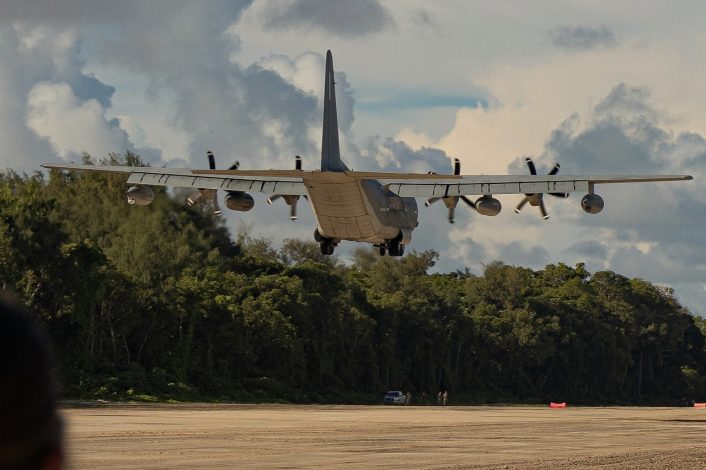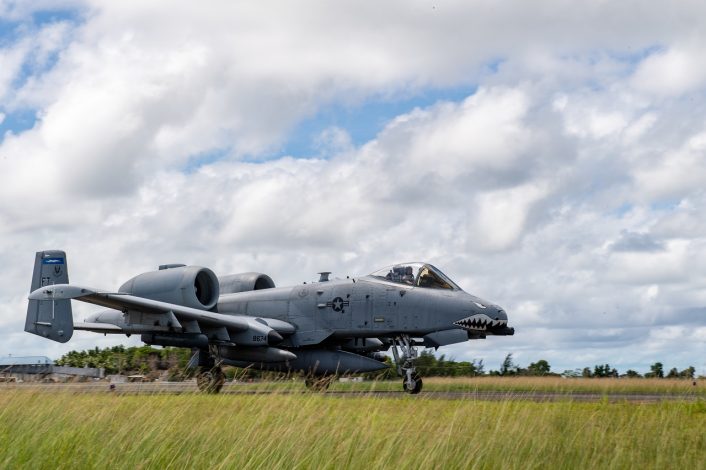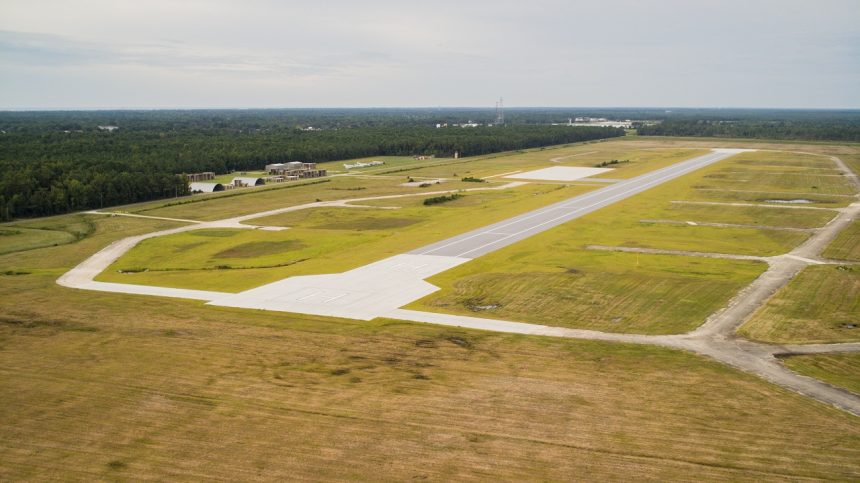After the first one in the Pacific few months ago, the USMC renovated and reopened another WW2 airfield in North Carolina which will serve as a multipurpose outlying landing field.
The U.S. Marine Corps has announced the reopening in August 2024 of a World War 2-era airfield in North Carolina, the former Army Air Corps airfield at Camp Davis. Thanks to a recent $28 million, 18-month overhaul, the resurfaced Davis South runway will now serve as a multipurpose outlying landing field (OLF) about 25 miles from Camp Lejeune.
According to the service, the new Davis South OLF can support every airframe in the Marine Corps’ arsenal, as well as other services’ aircraft up to the C-17 cargo aircraft. The OLF, which has minimal infrastructure, will be used primarily as a training platform, without units or aircraft based there.
The 4,525 foot airstrip includes a 3,600 foot asphalt runway and concrete turnarounds at each end to accommodate vertical take-offs and landings, with the total area of the airfield measuring 275 acres. The Marines said the entire runway was resurfaced with three layers of rock, gravel, and asphalt, while the concrete landing pads and apron were specially designed to handle high-intensity heat generated during hovering, landing, and turning maneuvers.
“The completion of Davis South represents a significant milestone for Camp Lejeune as one of this nation’s preeminent power projection platforms along the East Coast,” said Colonel Ralph J. Rizzo, Jr, commander, Marine Corps Installations East – Marine Corps Base Camp Lejeune. “Aviation and ground units across the region will be able to use this runway to exercise the full spectrum of training capabilities in preparation for missions around the globe, to include simulating austere airfield conditions in conjunction with Expeditionary Advanced Basing Operations.”
Camp Davis was originally created in WW2 as an anti-aircraft artillery training center of the Army, until its use was discontinued in 1946. In 1992, the installation was included in the Navy’s purchase of the Greater Sandy Run Training Area and used by Marine Corps rotary wing units from Marine Corps Air Station New River.

Peleliu airstrip
Two months before the Davis South OLF’s reopening, the Marines also recertified in June 2024 the historic Peleliu airstrip in Republic of Palau, in the middle of the Pacific. The service said the Marine Corps Engineer Detachment Palau (MCED-P) 24.1, comprised of engineers from the 7th Engineer Support Battalion, 1st Marine Logistics Group, was assigned the critical task of rehabilitating the WWII-era Japanese airfield, enhancing U.S. military strategic capabilities in the Indo-Pacific region.
On June 22, a KC-130J Super Hercules aircraft with 1st Marine Air Wing landed on the newly designated airstrip, marking the first landing of a military fixed-wing aircraft since it was recertified. The runway was named in honor of Eugene Sledge, a private first class with the 1st Marine Division during the Battle of Peleliu.
“Today is a historic moment as we land a Marine Corps aircraft on the ‘Sledge’ runway,” remarked Maj. Christopher Romero, MCED-P 24.1 commanding officer. “This remarkable achievement demonstrates the strategic importance of our mission and our dedication to regional stability and security.”
The airfield is in a strategic location, approximately 1,400 miles from Okinawa, Japan, where the bulk of USMC forces in the Pacific are based, and within 1,000 miles from the Philippines, a major partner nation of the United States in the area.
U.S. expanding their reach in the Indo-Pacific
With the heightened tensions in the Indo-Pacific region, especially with China, the United States are working to strengthen their forces in the area and deter a possible Chinese aggression. The U.S. Department of Defense published early in July 2024 a “modernization plan” aimed at strengthening forces in Japan.
Japan is a major hub where the bulk of the U.S. forces in the Indo-Pacific are located. -However, Japan is still too far from some major hotspots like Taiwan. That’s why the U.S. are working to extend their reach in the region with the creation of new bases hosted by partner nations and the reopening of older ones.
The Pacific theater of World War II saw some of the most intense air operations in history, where the vast distances and numerous islands made air power crucial for both sides. As a result, a network of airfields was established across the Pacific, many of which have been abandoned since the end of the war as they were no longer needed, both because of newer technology which allowed longer operational ranges and because the focus shifted to the European theater with the Cold War.
However, the recent developments in the geopolitical landscape are leading to a resurgence of these WWII-era airfields, with the goal of both extending the reach of U.S. forces with the creation of forward arming and refueling points (FARP) and dispersing assets to improve the survivability in the event of a Chinese missile attacks. Considered the Chinese expansion in the area, the refurbished bases also enhance the U.S. ability to respond to potential conflicts.
The use of these bases would fall under the Dynamic Force Employment (DFE) concept. By the way, the U.S. Air Force already tested the concept in Palau, with a detachment of A-10Cs operating out of a tent village at Roman Tmetuchl International Airport, well before Peleliu’s airstrip was ready.

Dynamic Force Employment
The Dynamic Force Employment (DFE) is the new strategy that combines strategic unpredictability with operational adaptability, first introduced by the 2018 National Defense Strategy. The key concept is to be operationally unpredictable in order to disrupt an adversary’s ability to respond and target allied forces.
An application of this strategy are the Bomber Task Force missions, during which the Air Force also describes DFE as the “ability to reach out from home station, fly anywhere in the world and execute those missions, rapidly regenerate from a forward operating base and continue operations.”
The term Dynamic Force Employment is usually adopted by the U.S. military as a whole, while the U.S. Air Force often refers to Agile Combat Employment (ACE) for its operations. However, the two are not necessarily distinct from each other.
In fact, during a DFE exercise which saw Hawaii’s F-22s deploy to MCAS Iwakuni, Japan, the service mentioned that “DFE operations fall under the scope of Agile Combat Employment capabilities which allows Pacific Air Forces to continuously exercise ways to improve passive and active defense capabilities to ensure a competitive advantage and to protect assets and personnel in the future.”
Specifically, the Agile Combat Employment has been defined by the Air Force in its doctrine as “a proactive and reactive operational scheme of maneuver executed within threat timelines to increase resiliency and survivability while generating combat power.” The service also added that agile here means being “able to outpace adversary action through movement and maneuver to achieve commander’s intent.”
ACE essentially involves operating from austere airfields, large roads and highways with little supporting and technical infrastructure, dispersing assets out from the larger air bases that are likely to come under a sudden volume of Russian or Chinese tactical ballistic and cruise missiles. The strategy, while complicating adversary planning, also allows to hold adversary targets at risk from multiple locations.
DFE is thus not necessarily separate from ACE, although we saw a preponderance of the U.S. of the term ACE during Air Force-only exercises or from austere locations, while DFE is seen used during joint operations or from more prepared military facilities at forward locations. In both cases there is the element of the quick movement of forces, and the ability to operate soon after reaching the deployed location.









